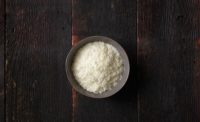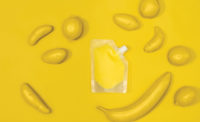Potatoes USA: Gluten Free Option
An innovative, cost-effective solution for gluten-free product development, potatoes offer many benefits as a breading, crust or coating






From mozzarella sticks to chicken tenders, breaded foods are some of the US’ most beloved appetizers and entrees. Today, many Americans are challenged with restricting or eliminating gluten, which can mean giving up some of their favorite foods.
Gluten-free products rely on a combination of various flours and starches to replicate the functional properties of wheat flour. However, potatoes in several forms serve as an excellent gluten-free alternative to wheat-based breading agents.
For the standard three-step breading process of flour, egg and breadcrumbs, instead start with potato flour and finish with potato flakes for a delicious, gluten-free alternative. Potato flour is an ideal replacement for wheat flour. It provides a barrier between the base ingredient, a chicken breast for example, and the breading. The potato flakes impart an evenly coated finished product, which allows for even baking or frying.
Dehydrated potato flakes are a great alternative to traditional breadcrumbs for coating—mimicking the texture and adherence properties—to achieve a golden, crispy outer crust. Typically, gluten-free products do not brown as well as wheat-containing products, but the natural sugars found in potatoes produce the Maillard reaction that gives browned food its delicious, savory flavor1. Potatoes improve browning, color and flavor development. Plus, their neutral flavor marries well with herbs and seasonings to enhance the overall flavor profile.
A potato flake finish creates a uniform, crunchy texture and perfect crust without overcooking the hero ingredient. Thanks to the non-starch polysaccharides that make up the crude fiber of the potato, they offer a moisture barrier that leaves the product moist with an evenly browned coating, especially when pan seared, broiled or fried2. These fibers absorb many more times their weight in water which helps produce moist foods with desired textural properties.
When it comes to gluten-free toppings or coatings, try shredded, sliced and diced potatoes for a unique look and texture. Choose potatoes instead of traditional breadcrumbs or cornmeal for toppings and coatings, such as an herbed topping for vegetables and proteins or a crispy topping for casseroles. Spiralized or shredded potatoes—whether fresh or frozen—make for an eye-catching crust. Utilizing dehydrated potato shreds that have been rehydrated before cooking also provide ideal storage and prolonged shelf life solutions.
An innovative, cost-effective solution for gluten-free product development, potatoes offer many benefits as a breading, crust or coating.
For more from Potatoes USA, visit www.PotatoGoodness.com/ingredient.
NOTES
1.Stasiak M., Molenda M., Opalinski I. Blaszczak W. “Mechanical Properties of Native Maize, Wheat, and Potato Starches.” Czech Journal of Food Science (2013): 31(4). https://www.agriculturejournals.cz/publicFiles/97020.pdf.
2. Lisinkska, G. and Leszcynski, W. “Potato science and technology.” Springer Science+Business Media (1989): Chapter 2.
Looking for a reprint of this article?
From high-res PDFs to custom plaques, order your copy today!








